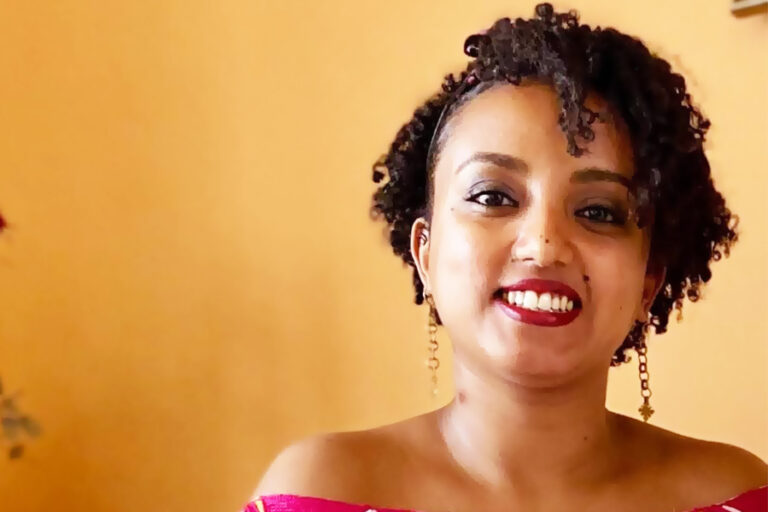“…stay true to yourself, be confident in your abilities…”
Artist Desta Hagos
As we celebrate International Woman’s Day 2021, here in Ethiopia, we are still commemorating one of the most powerful and fearless Ethiopian Queens, Etege Taitu, who helped her husband defeat the fascist Italians at Adwa. History helps shape our future, undoubtedly, and Ethiopian women continue to shine. Adwa born contemporary Ethiopian Artist Desta Hagos is at the top of my list for those who make Ethiopia proud. I hereby dub Desta the “Queen of Ethiopian Contemporary Art” for many good reasons, and not just because she has been my friend for many years. But don’t take my word alone for it. According to another exceptional Queen Mother (born across the pond) Rita Pankhurst, “Desta set an example for Ethiopian women.” Pankhurst contributed a heartfelt piece about Desta in 2014 for an exhibition I curated with the female wonder at the National Museum of Ethiopia. It is well worth sharing.
“Desta Hagos is the first woman to have devoted her entire life to the production of works of art. At time of her graduation with distinction in 1969 the first three Ethiopian artist – all men – to return to Ethiopia after studying abroad – Afewerk Tekle, Gebre Kristos Desta and Eskender Boghosian – had come either to live or at least to visit Ethiopia. Of these was Gebre Kristos Desta…who influenced many young Ethiopian artists as their teacher at the Fine Arts School. He taught Desta four of her five years as a student and encouraged her to paint abstract as well as the better established and more popular figurative art.” Rita goes on the write, “After her graduation Desta realized that she was prepared to set aside any activities that would distract her from painting… . Although she married, turbulent times in Ethiopia separated her from her husband…during her pregnancy. She managed on her own to raise her daughter and to see her through school and university. Desta set an example for Ethiopian women, and other African women that a woman could indeed be a full-time artist. She blazed a trail for them, showing that it was possible to not only dedicate oneself to art but also to earn enough to make a living from it. Her perseverance, through thick and thin, has earned her the respect and admiration of the many women artists working today who take it for granted that they are the equals of men artists, and participate equally in the many exhibitions which enliven Addis Ababa today.” By Rita Pankhurst, excerpt from DESTA HAGOS 50th Exhibition Catalogue.
Desta Hagos is barley 5 feet tall with a tiny frame yet she creates ‘larger than life’ works of art in her equally tiny 2m x 3m art studio, in her Kazanches studio-apartment. The Queen of Contemporary Ethiopian Art hails from a humble family. Her dad doted on his daughter, providing the curious child her first artistic medium, crayons, in the 1950’s. This gesture was to help her satisfy her fascination with flowers. By the 1960’S Desta was surrounded by male counter-parts at art school, now Alle Felege School of Fine Art, graduating in 1969. She would have her first solo show that year and according to the June 6, 1969 Addis Reporter’s review, “This exhibit not only shows serious of purpose and dedication but also hard work. It consists of 28 oils and four water color and pastels. It should not come as a surprise if Desta in the future develops even more of a sensitive use of color and a release of genuine aesthetic emotion through this use.” So said so done.
By the 1970’s Desta travelled to California to earn a degree in Fine Art. It was a tense time as the Dergue wreaked havoc on her beloved country. Desta had a choice; stay and carve out a safe and successful career in art, or return home to a fate unknown. She chose to go home. It would prove to be one of the most difficult decisions of her life, but one she never regretted. The determined Desta continued to paint, even sometimes painting over expressions that the regime would not have found acceptable, and could have caused harsh consequences due to the political climate. Yet she never stopped and never surrendered her greatest passion, painting. By the 90’s, after the downfall of the Dergue, she was able to begin painting freely; swiftly becoming one of the most celebrated artists of her time in Ethiopia, expressing herself exquisitely.
Desta has lived through lots and shares her experience and advice with a new generation of not only female artists but women in general. “I never doubted myself or my ability and I worked hard to make sure I made my dreams come true. I have travelled to different countries and my work hangs in museums, galleries, homes and offices of people from many different walks of life, and that makes me feel good, but I still know I have more to accomplish. My advice, stay true to yourself, be confident in your abilities and love your country and culture.” The Queen of Ethiopian Contemporary art is royalty for not just her creativity but her confidence, discipline, devotion and loyalty to her truth. Desta Hagos is an example to all women and especially young women that though you may choose a difficult path, particularly male dominated, use your passion and focus to drive the sacrifices you make along the way, in order to not only succeed but to clear a path for other women to walk more freely in the future.
Dr. Desta Meghoo is a Jamaican born
Creative Consultant, Curator and cultural promoter based in Ethiopia since 2005. She also serves as Liaison to the AU for the Ghana based, Diaspora African Forum.




